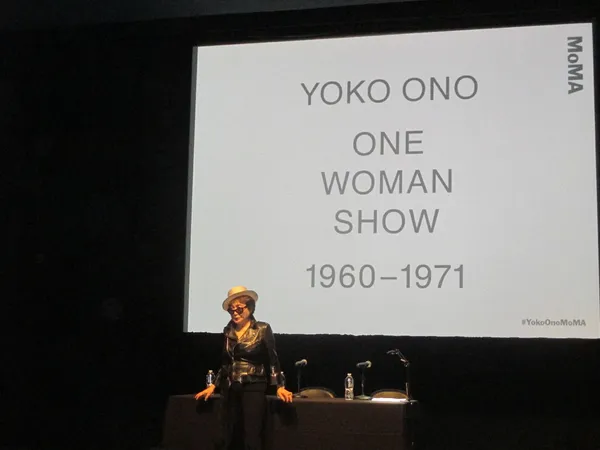 |
| Yoko Ono: One Woman Show, 1960 - 1971 press preview at MoMA Photo: Anne-Katrin Titze |
At the press preview for Yoko Ono: One Woman Show, 1960 - 1971, the Museum of Modern Art Director, Glenn D. Lowry, introduced the co-curators, Klaus Biesenbach, Chief Curator at Large, MoMA, and Director, MoMA PS1 and Christophe Cherix, The Robert Lehman Foundation Chief Curator of Drawings and Prints.
Yoko's exhibition includes nine 16mm films - Albert Maysles and David Maysles' Cut Piece, the John Lennon and Yoko Ono Bed-In from 1969, Match Piece (One), Eyeblink, Fly, Film No. 5 (Smile), Wrapping Event, Film No. 4, and The Museum Of Modern Art Show 1971.
_225.webp) |
| Albert and David Maysles' Cut Piece (1965) Carnegie Recital Hall, NYC |
The infamous The Museum Of Modern Art Show 1971 consists of interviews Yoko conducted in front of MoMA in 1971 about her Yoko Ono: One Woman Show - a show that did not take place at the museum then but does now. In a sort of Chris Marker La Jetée move, the exhibition encounters itself as on a Möbius strip in time. The film has people react to the nonexistent show they were asked about. Some said they saw it, others that they are looking forward to seeing it. Their insincerity or naiveté is beautifully turned on its head by the actual exhibition of 2015.
Albert and David Maysles' Cut Piece, performed at the Carnegie Recital Hall in 1965, still produces a strong emotional response. The piece has Yoko sit on a stage with members of the audience taking turns cutting off her clothing employing a large pair of scissors. Especially poignant is a young man with a lecherous and cruel expression on his face, captured by the Maysles' camera. While cutting Yoko's undergarments with a smirk, he is not even aware how much he exposes of his own ugliness, instead of Yoko's nakedness. The expressions are fascinating to watch and have lost none of their power in 2015.
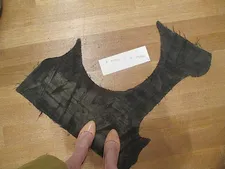 |
| A WORK TO BE STEPPED ON - Yoko Ono Photo: Anne-Katrin Titze |
Fly follows what flies do.
Film No. 4 (Bottoms) shows the four corners of people's behinds as if they were buns being baked.
An early film of Yoko's, Match Piece (One), which is Fluxfilm no.14, about lighting a match is just that and of course much more if you think about enlightenment.
Yoko Ono's eye for film comes alive in her writings as well. Some of the instructions in Grapefruit (1964), read like a script, given to the spectators to make their own movies. Conversation, contact with others, is and has always been key for Yoko. If it takes for you to bandage a nonexistent wound and tell stories about it or for her to collaborate with a once dreaded "institution," it is worth it. How difficult this can be was shown at the press preview by the one space that people fled like the plague. Right behind where Cut Piece was screened, there is an empty room with a sign in the middle stating: touch eachother.
A work labeled A WORK TO BE STEPPED ON (Painting To Be Stepped On 1960/1961) is easier for people to do. And if you are particularly daring, you can climb into Yoko's famous Bag Piece (1964) with someone, take your clothes off and put them on again. The artist will make surprise visits to the exhibition during its run.
 |
| Site-specific work To See The Sky at MoMA - Yoko Ono Photo: Anne-Katrin Titze |
Among the works on exhibit: Ceiling Painting (1966), which famously brought Yoko and John Lennon together, Half-A-Room (1967), Painting To Hammer A Nail (1961/1966), which looks inviting but is not to be touched, Touch Poem #5 (c.1960), and a new site-specific work created for the exhibition, To See The Sky.
Here is what MoMA and Yoko had to say at the press conference in Titus Theater 2:
Glenn D. Lowry: This exhibition for me, and I am sure for Christophe and Klaus, is an extraordinarily important event - a kind of journey for us which began really in 2008 with the gift of the Gilbert and Lila Silverman Collection of Fluxus. This gift was monumental in terms of the Museum of Modern Art. It let us go from having a very poor, one might even say, absent presence in terms of Fluxus to having a foremost collection of Fluxus, certainly in North America and possibly in the world. What we learned when we started to investigate that extraordinary collection was the singular role and importance of Yoko Ono.
We took the idea of a One Woman Show from Yoko herself who staged a kind of conceptual project here at the Museum of Modern Art in 1971. I should say, we didn't know about it. She simply staged it. We took as our point of departure the exhibition she could have, or would have had in 1971, had we been prescient enough to do the show. We're so happy, Yoko, that you allowed us so many years later to work with you on this remarkable exhibition.
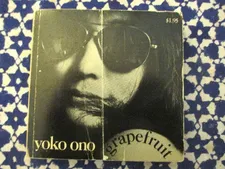 |
| Yoko Ono Grapefruit inscribed - collection Ed Bahlman (not in exhibition) Photo: Anne-Katrin Titze |
Lowry then turned over the press conference to the co-curators.
Klaus Biesenbach: In 2008, parallel to the Silverman Collection coming to MoMA, also amongst all the colleagues at MoMA we did research in the performance workshop and all different departments contributed important performance happenings, interventions around MoMA, at MoMA and of course we came across Yoko Ono: One Woman Show,1971. The beautiful book you printed and the documentary where you asked how people liked the show. And they liked it even though it was just a conceptual show. It's a huge gift that you allow us to uncover this exhibition as if it happened in 1971.
I was just going through Grapefruit this morning. Two pieces are like a metaphor for what this exhibition 44 years later actually is. One is the throwing piece: "Throw a stone into the sky high enough so that it will not come back." That's from 1964, that's 51 years ago. The other one is a clock piece. Usually a clock is placed at the centre of a stage and the audience is asked to wait until the alarm goes off. The alarm went off and I'm very, very proud and grateful that I could work on this show with Christophe.
Christophe Cherix: We started with one shared belief, that the work should be allowed to speak for itself. For this reason the first thing that you encounter when you enter this exhibition is a single piece in an empty room. Apple has also been shown in the past but perhaps never quite like this before. Apple was first presented in 1966, the midway point of our show.
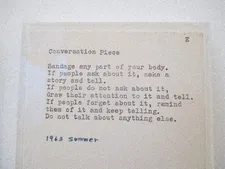 |
| Conversation Piece from Grapefruit (1963 summer) - Yoko Ono |
Yoko Ono: I was thinking when I did the show in 1971 it was fun to do it. I actually created a very elaborate catalogue and thought people would buy it or something. I don't think anybody did. A few people maybe bought it. I was taking this conceptual exhibition very seriously. We should do that anyway, even if nobody notices. That's how I always feel - wow, that's a great idea, let's do it. And then, well, if nobody notices it, that's okay too…
I think about ten years ago, there was a call from the Museum of Modern Art. They said, "we have this record that you have done a show with us. Would you please tell us what it was about?" When people say something like that, instead of getting really angry or surprised, "how dare you don't know what it was about?" I always go to, maybe like most women, I don't know, "okay, don't worry about that." And that's how I survived, actually. Then, I got a call from Klaus.
I realised that both Christophe and Klaus understood what I did in 71. I thought it was incredible. Who even noticed that I did this show?… I don't know how I did it really. 40 years not being recognised and just doing it? … It's really good to know that everything you do is going to be recognised by people.
The thing you do is understood by people and one day it's going to blossom. And that's the reason why I am here now and we're doing this show.
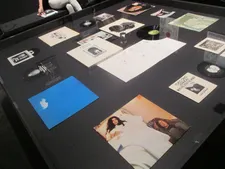 |
| Yoko Ono: One Woman Show, 1960 - 1971 recordings Photo: Anne-Katrin Titze |
… "the thing is, we're all alive and to sustain our life we have to create a better world. And it's really getting a little bit bad. Then it's much better to do something about it instead of just being a couch potato. When John and I started doing something, we were still young and not many people were interested in World Peace… I would prefer to give another chance to our world and we can do that.
A new text by Yoko Ono, called Uncover, contains the line: "World peace is right in front of our eyes like on a giant movie screen."
Yoko Ono: All we have to do is to pave all highways of the planet with solar powered panels. So there will be no more need of piping for oil and gas. It will stop all wars. And use stem cells to heal. We're already doing it. In very religious countries they can't do it. I heard that from my dentist that they already have a way of growing teeth, but they don't know how to stop it. That's why they can't use it. Uncover, not discover. There's more change we have to make - but it's worth it.
The exhibition is made possible by illy with major support provided by MoMA’s Wallis Annenberg Fund for Innovation in Contemporary Art through the Annenberg Foundation, BNP Paribas, and The Modern Women’s Fund. Additional funding is provided by the MoMA Annual Exhibition Fund.
Yoko Ono: One Woman Show, 1960–1971 will open to the public on May 17 and run through September 07, 2015 in the International Council of New York's Museum of Modern Art Gallery on the sixth floor.





















